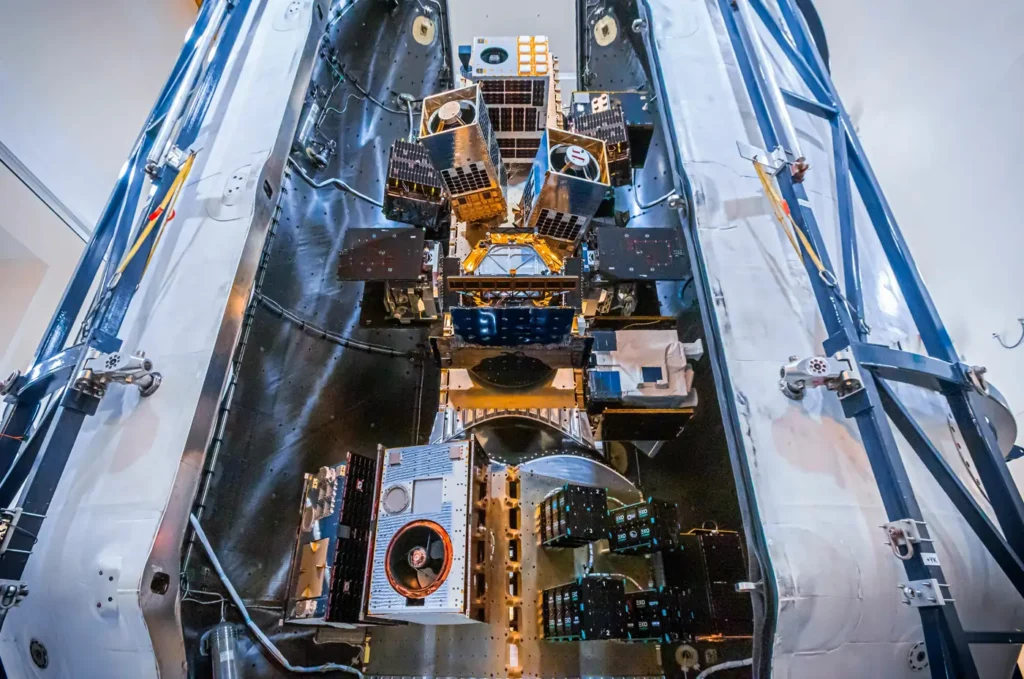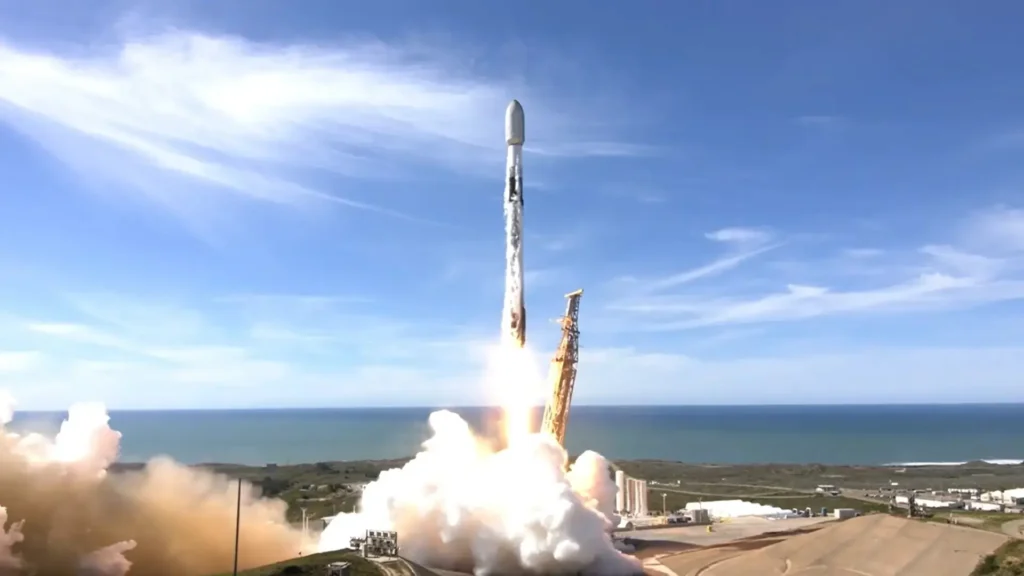On March 4th, SpaceX marked another milestone with the successful launch of its tenth Transporter rideshare mission. This mission, characterized by the deployment of more than 50 small satellites, showcased the continued demand from satellite developers for cost-effective launch solutions. However, amidst the excitement of this achievement lies a pressing concern: the increasingly complex landscape of space situational awareness.
Table of Contents
The Launch: A Multifaceted Payload
The Falcon 9 rocket lifted off from Vandenberg Space Force Base in California, propelling the Transporter-10 mission into orbit. Over the course of more than an hour and a half, the upper stage deployed a diverse array of payloads, totaling 53 satellites. Among these were stalwarts like Spire, Iceye, and Satellogic, each contributing to various sectors such as weather forecasting, radar mapping, and imaging services.

New Entrants into the Space Race
The Transporter-10 mission also marked the debut of several companies in the space industry. Lynk Global, on the brink of a public debut through a SPAC merger, launched two satellites as part of its ambitious direct-to-device constellation project. Unseenlabs, buoyed by recent funding success, added two maritime tracking satellites to the constellation. Loft Orbital introduced YAM-6, its innovative “virtual mission-enabled” satellite, promising adaptable imaging solutions for customers.
Innovations in Satellite Technology
Amidst the diverse payload, notable innovations emerged. Space Machines, an Australian startup, showcased its Optimus spacecraft, designed to demonstrate on-orbit maneuvering and servicing technologies. Atomos Space, a Colorado-based company specializing in orbital transfer vehicles, launched its Quark-lite and Gluon spacecraft, heralding a new era in propulsion technology. True Anomaly and Quantum Space also made strides with their respective satellite inspection and geostationary orbit technology demonstrations.
Addressing Environmental Concerns
The significance of satellite technology in addressing global challenges was underscored by the inclusion of MethaneSAT in the Transporter-10 payload. Developed by Ball Aerospace for the Environmental Defense Fund, MethaneSAT aims to track global emissions of methane, offering a crucial tool in combating climate change.
Navigating the Challenges of Space Traffic Management
However, the success of rideshare missions like Transporter-10 comes with its own set of challenges, particularly in the realm of space traffic management. Owen Marshall of LeoLabs highlighted the increasing difficulty in cataloging objects post-launch, attributing this to the proliferation of rideshare missions. The sheer volume of satellites deployed in these missions poses a significant tracking challenge, with implications for both operational efficiency and space safety.
Mitigating Risks and Ensuring Space Safety
The delayed cataloging of satellites post-launch not only hampers early operational activities but also elevates the risk of collisions in space. Araz Feyzi of Kayhan Space emphasized the urgency of addressing this issue, advocating for enhanced tracking capabilities to mitigate potential risks. The discussion extended to the broader implications for national security, underscoring the need for proactive measures to safeguard space assets.
Lessons from SpaceX’s Starlink Program
In contrast to the challenges posed by rideshare missions, SpaceX’s Starlink program stands out for its robust approach to satellite tracking. Marshall commended SpaceX’s proactive stance in space traffic management, highlighting the company’s meticulous tracking of satellites even before official cataloging by defense authorities.
Conclusion
The Transporter-10 mission epitomizes the dual nature of contemporary space exploration – a testament to technological innovation and a harbinger of the challenges that lie ahead. As satellite deployment becomes increasingly commonplace, stakeholders must prioritize collaborative efforts to ensure the long-term sustainability and safety of space operations.
Reference
Frequently Asks Questions (FAQs) Related to Falcon 9
What is the Falcon 9 rocket?
The Falcon 9 rocket is a two-stage orbital launch vehicle developed and operated by SpaceX.
Who owns SpaceX, the company behind the Falcon 9 rocket?
SpaceX, the company behind the Falcon 9 rocket, is owned by Elon Musk.
What is the purpose of the Falcon 9 rocket?
The Falcon 9 rocket is designed to launch payloads, including satellites and spacecraft, into various orbits, and it is also capable of carrying crewed missions to the International Space Station (ISS).
How tall is the Falcon 9 rocket?
The Falcon 9 rocket stands approximately 70 meters (229.6 feet) tall.
How much payload can the Falcon 9 rocket carry to low Earth orbit (LEO)?
The Falcon 9 rocket can carry up to 22,800 kilograms (50,300 pounds) to low Earth orbit (LEO).
How many engines does the Falcon 9 rocket have?
The Falcon 9 rocket features nine Merlin engines on its first stage and one Merlin Vacuum engine on its second stage.
What type of fuel does the Falcon 9 rocket use?
The Falcon 9 rocket uses rocket-grade kerosene (RP-1) as fuel and liquid oxygen (LOX) as oxidizer.
How many stages does the Falcon 9 rocket have?
The Falcon 9 rocket has two stages: the first stage, which provides initial thrust during liftoff, and the second stage, which continues the journey to orbit.
What is the cost of a Falcon 9 rocket launch?
The cost of a Falcon 9 rocket launch varies depending on the mission’s requirements but typically ranges from $62 million to $67 million.
How many successful launches have the Falcon 9 rocket completed?
As of January 2022, the Falcon 9 rocket has completed over 150 successful launches.
What is the Falcon 9’s reusability concept?
The Falcon 9 rocket is designed for reusability, to reduce the cost of access to space by refurbishing and reusing its first stage.
How many times can a Falcon 9 first stage be reused?
The Falcon 9 first stage can be reused multiple times, with the record currently standing at ten flights for a single booster.
What is the maximum payload capacity for a Falcon 9 launch to geostationary transfer orbit (GTO)?
The Falcon 9 rocket can deliver payloads of up to 8,300 kilograms (18,300 pounds) to geostationary transfer orbit (GTO).
What is the Falcon 9’s track record in terms of successful launches and landings?
The Falcon 9 rocket has a successful launch and landing record, with a high rate of mission success.
How does the Falcon 9 compare to other rockets in terms of performance and cost?
The Falcon 9 rocket offers competitive performance and cost advantages compared to other launch vehicles in its class.
What are some notable payloads that the Falcon 9 has launched?
Notable payloads launched by the Falcon 9 include communication satellites, scientific payloads, and cargo missions to the ISS.
How does the Falcon 9’s recovery system work for its first stage?
The Falcon 9’s first stage features grid fins and landing legs, allowing for controlled descent and landing either on a drone ship at sea or on land.
What are some of the future plans for the Falcon 9 rocket?
Future plans for the Falcon 9 rocket include continued launches of commercial, government, and crewed missions, as well as further advancements in reusability and reliability.
How does SpaceX ensure the safety and reliability of the Falcon 9 rocket?
SpaceX employs rigorous testing, quality control measures, and redundant systems to ensure the safety and reliability of the Falcon 9 rocket.
What are some of the key advancements or improvements made to the Falcon 9 rocket over time?
Key advancements to the Falcon 9 rocket over time include improvements in engine performance, reusability enhancements, and upgrades to avionics and manufacturing processes.


